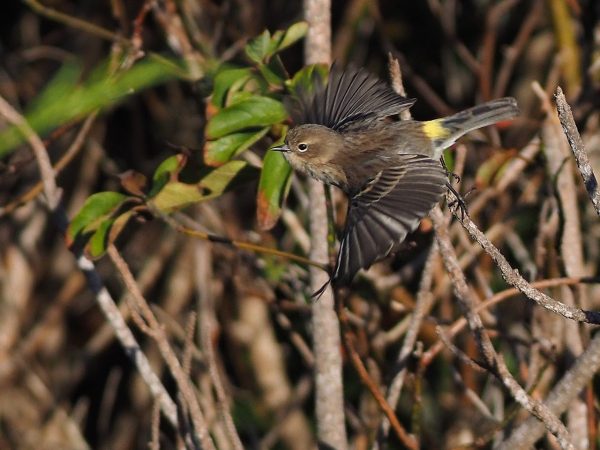Warblers are a celebrated group of birds, and for good reason. They’re beautiful, they’re very diverse, and they’re temporary – warblers are among the many types of birds that only hang around temperate regions for short periods of time.
Here in the northeast, warblers show up in spring, around the same time that insects become plentiful, and they exploit that resource to rear their young. Basically, many species breed here in the spring and summer, and then head somewhere warmer before the weather becomes unfavorable for finding insects to eat.
Some warblers travel extraordinary – almost unbelievable – distances. The Blackpoll Warbler (Setophaga striata) can travel nearly 12,000 miles round trip every year, which often includes a 3-day, nonstop, 1,800-mile flight over the Atlantic Ocean to Puerto Rico, the Lesser Antilles, and northern South America. (Most warblers won’t travel quite that far, but it speaks to their migratory abilities.)
So we have an abundance of local warblers to appreciate each summer here in the northeast before they leave for winter. However, there is one warbler in Pennsylvania who’ll endure our frigid (albeit decreasingly frigid) winters. That species is none other than the Yellow-Rumped Warbler (Setophaga coronata)!
THE NAME: We can all appreciate an aptly named species. There’s no shortage of species whose names make little to no sense, or pay tribute to people who had little to no association with their discovery, study, or conservation. The Yellow-Rumped Warbler is named so because of its, you guessed it, yellow rump. Trying to sort out the minute details of a warbler in the field can be challenging, but this species provides an easy identifying feature for which it has been named. I can remember this being one of the first warblers I felt confident identifying.

Yellow rump on the Yellow-Rumped Warbler. So nice when names make sense.
RANGE: Yellow-Rumped Warblers can be found coast to coast, spanning from their northernmost breeding grounds in Canada and Alaska all the way down to where they overwinter, as far south as southern Panama.
HABITAT: During the breeding season, Yellow-Rumped Warblers tend to occupy coniferous to mixed coniferous forests. Along the east coast and in the Pacific Northwest, interestingly, they can be found from higher elevations all the way down to sea level, but in most of the western U.S. and the central Appalachians they’re typically restricted to the mountains. In their tropical overwintering grounds they can be found in places such as coffee plantations, mangroves, pine-oak fir forests, and thorn scrub environments.

Breeding plumage of the Yellow-Rumped Warbler. (Photo courtesy of Bill Kunze)
DIET: This species can stick around colder regions during the winter in part due to its flexible diet. As is the case for most of our birds, Yellow-Rumped Warblers focus on consuming insects during the breeding season. During the winter though, they adapt and switch to eating fruit. They’re particularly fond of eating Bayberries and are the only warblers who can digest the waxy coating of their fruits. Bayberries are found in cooler reaches of the country, so it’s thought that their distribution has allowed Yellow-Rumped Warblers to remain farther north than other warblers each winter. That being said, Yellow-Rumped Warblers consume a diversity of fruit outside of the breeding season, including those produced by junipers, dogwoods, virginia creeper, wild grapes, and even poison ivy. Just another example of the importance of native plants!
NESTING: This species will nest at a variety of heights, but primarily within conifers, hence their affinity for coniferous forests during the breeding season. They will nest within pines, hemlocks, tamaracks, spruces, Douglas-firs, and even white cedars. Over the course of about 10 days, female Yellow-Rumped Warblers construct the nest, often with materials that are collected by their male counterparts. Their nests consist of a cup shaped collection of twigs, pine needles, and grass. They also incorporate things like moss and animal hair to add some protection for their eggs.

White Pine (Pinus strobus). One of several native conifers that Yellow-Rumped Warblers will utilize.
BEHAVIOR: Yellow-Rumped Warblers are really fun to watch, in part because of the diversity of places and scenarios in which you can find them. They can be spotted foraging high up in the canopy, but they’re often observed gleaning insects from lower branches, similar to how flycatchers catch their food. In my experience, they’re also relatively less-skittish than some of our other birds, making them a great species to use to practice bird photography. They aren’t as easy to photograph as a domestic Mallard would be, but they aren’t as difficult to capture as Cerulean Warblers either. Another cool aspect of their behavior is that they’ll often join mixed-species flocks in winter to search for food. If you spot this species, keep an eye out for others!

Yellow-Rumped Warbler on the move, as they often are. (Photo courtesy of Bill Kunze)
While it isn’t ideal to have to say goodbye to so many amazing warblers each summer, we at least have one to appreciate year round. And lucky for us, Yellow-rumped Warbler numbers appear to have remained stable over the past half a century or so. So barring any catastrophes, we should be able to appreciate these birds for many winters to come. Keep an eye out for our lone warbler. Thanks for reading.
Author Sebastian Harris is a Heritage Conservancy Conservation Easement Steward. Read other Nature Notes.
RESOURCES: https://www.allaboutbirds.org/guide/Yellow-rumped_Warbler/overview
